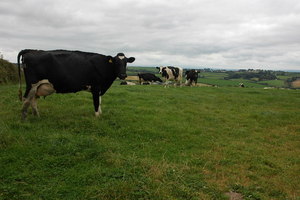About six months ago, I began buying raw milk.
Well, that’s not quite accurate. About six months ago, I bought one share in a herd of dairy cows, which gives me one gallon of raw milk per week. It’s not legal in my state to purchase raw milk. The U.S. Department of Agriculture feels it’s too dangerous and that I should not be permitted to drink it even if I want to. However, it is legal to drink raw milk from cows that you own. Since I live in a trailer park and don’t have the space to raise my own milk cow, I decided to join a herd share program instead.
I didn’t initially set out to obtain raw milk. Rather, I wanted to purchase fresh milk from a local farm, milk that came from cows that were not treated with antibiotics or hormones. Most importantly, I wanted to purchase milk that came from cows that were raised on pasture, fed grass and hay (which is what cows are supposed to eat), and treated humanely. Most of the time when you purchase milk from a grocery store, it comes from a “factory farm,” a large warehouse-like business where cows are kept confined to tiny stalls, fed a poor diet, forced to stand in their own waste and generally treated in inhumane ways. I did not want to support such businesses when I purchased milk.
When I began searching for a local farm from which to purchase milk, I discovered that most small farms do not offer pasteurized milk for sale to the public. Of course, most small farms do not offer raw milk for sale, either, since that is illegal in most states. But I learned about herd share programs and found that I could, for a reasonable fee, purchase a share in a herd of dairy cows. I would then pay a small monthly fee for the board and care of the cows, and that would entitle me to some legal raw milk. It seemed like a good deal to me.
Since then, I’ve learned a lot more about raw milk. There are many other reasons for which I will continue to use it. For instance, milk is actually supposed to contain some bacteria, “good” bacteria, like that found in yogurt. Pasteurizing milk kills any bad bacteria in it but also kills the good bacteria. Also, raw milk contains an enzyme called lactase which helps people digest lactose, the natural form of sugar found in milk. Pasteurizing milk destroys the lactase. Because of this, many people that are lactose intolerant can tolerate raw milk but not pasteurized milk. My partner used to get terrible gas whenever he drank milk, but he can drink raw milk with no trouble at all.
Still, the humane treatment of the dairy cows remains my primary motivation for using raw milk. I love driving out to the country to the farm to pick up my raw milk. As I turn into the unpaved drive, I can see the cows out in the pastures. Sometimes they are in the pasture alongside the drive, and I can see them up close as they graze on the grass and chew their cuds. Sometimes they are in the far pasture, and I can see them spread out on the other side of the pond, looking peaceful and serene. Each time I see them, I’m reminded of why I go to the trouble to get raw milk instead of picking some up at the grocery store.
Sources:
Sustainable Table. http://www.sustainabletable.org/issues/eatlocal/. Eat Local, Buy Local, Be Local.
Green Living. http://www.greenlivingonline.com/article/benefits-buying-local-food. Benefits of Buying Local Food.
Food and Drug Administration. http://www.fda.gov/Food/ResourcesForYou/consumers/ucm079516.htm. Then Dangers of Raw Milk: Unpasteurized Milk Can Pose a Serious Health Risk.




